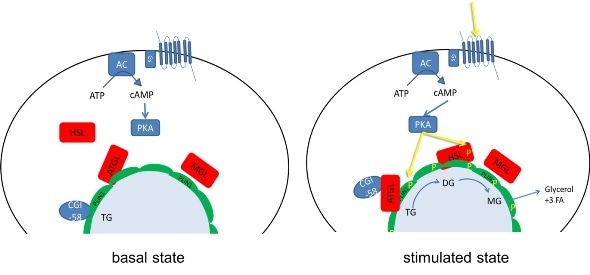Aug 16 2017
What happens and where, when the body’s fat stores are activated? With the support of the Austrian Science Fund FWF, the biochemist Ruth Birner-Grünberger investigates the complex interaction of activation and regulation in fat breakdown, thus providing a basis for new therapeutic approaches for illnesses such as diabetes or arteriosclerosis.

In a basal state (on the left before the hormonal lipolysis signal occurs), the activating protein CGl58 and the regulating protein perilipin are bound together. Once lipolysis is activated (on the right), one of the two proteins is marked with phosphate (phosphoryliation) and CGI58 separates from peripilin to activate the first of three lipases (enzymes that break down fat) named ATGL. Quelle: Ruth Birner-Grünberger, Meduni Graz
Every marathon runner gets to this point: after exhausting the fast energy provided by glucose (from carbohydrates), the body starts burning fat. When we exercise continuously at a low pulse rate, lipolysis starts after about 30 minutes. The same thing happens when we are hungry: the fat cells receive a hormonal signal telling them to make a depot available and break down the stored lipid droplets into fatty acids. Even when we move at only a fast walking pace, these processes occur in the body at lightning speed. “The activation and control processes are launched within seconds. This is only possible because the proteins needed to break down the fat cells do not have to be created but are only unlocked.” In her FWF-funded project
Hormonal Regulation of Lipolysis, the biochemist Ruth Birner-Grünberger studied three things: which proteins were involved in fat burning, where their interaction in fat cells occurs and how they are mobilized or inhibited.
Phosphate acts as switch
Birner-Grünberger has been investigating lipolysis since her postdoc period in 2002. In her research unit at the Institute of Pathology at the Medical University of Graz, she develops technologies for proteomics: “It involves trying to detect proteins based on their activity in specific metabolic processes”, says principal investigator Birner-Grünberger. When looking for lipolytic enzymes in fatty tissue and in the liver in preliminary studies, several candidates were identified: “There are several lipases, i.e. proteins that break down fat, plus other proteins that regulate the process.” Particularly striking for the researchers was the amount of phosphorylation they found. Phosphorylation is a chemical modification that binds phosphates to proteins and thereby serves to activate or inhibit proteins in cells. This consumes less time and energy than launching protein synthesis or degradation anew every time. The research project was designed to answer the question as to when and where chemical modifications unlock or inhibit the proteins involved in lipolysis.
In vitro studies were not sufficient, however, to explain the interaction of the lipolytic proteins. “The biological system is complex, strictly regulated and location-dependent. We cannot achieve a complete picture by just mixing fat droplets, lipase and an activator in a test tube”, explains the researcher. Success was achieved only when the scientists observed animal cells by means of a confocal laser-scan microscope, since “research today means co-operation”, as the biochemist emphasises, who collaborated with the structural biologist Monika Oberer (University of Graz) and the cell biologist Dawn Brasaemle (Rutgers University, New Jersey, USA) in order to get an adequate amount and quality level of protein for the test series.
Spatially and temporally paced activation
This is how they were able to discover the first steps of spatial and chemical interaction on the fat droplets in tissue cells: in order to activate the first (of three) lipases, one needs a chain of command including the activator CGI58 and the regulator perilipin. When the fat cells are in a basal state, the two proteins are sitting on the lipid droplet bound together. Upon marking with phosphate they separate, CGl58 travels to another spot on the droplet in order to activate the first lipase (ATGL). As a regulator, perilipin prevents the lipases from being activated when they are not required. This is interesting to know, because common illnesses such as diabetes and arteriosclerosis are encouraged by an overloaded lipid metabolism. If the body is supplied with more energy than it can burn for a long time, this leads to a disturbance of a carefully paced and spatially balanced system.
The head of the Functional Proteomics and Metabolic Pathways research unit plans a follow-up project during which she intends to use phosphoproteomics (i.e. the global analysis of thousands of protein phosphorylation processes in cells) to understand which energetic processes are regulated simultaneously with lipolysis, such as glycogen degradation, and to observe the temporal sequence. “It looks as though fat cells are able to adjust within minutes to the fact that fatty acids are required and to how they are processed further. We not only need them for delivering energy, as in the case of exercise or hunger, but also for building cell membranes and signaling molecules.” In order to carry out these analyses, the project group also developed a method for the improved evaluation of proteomics data.